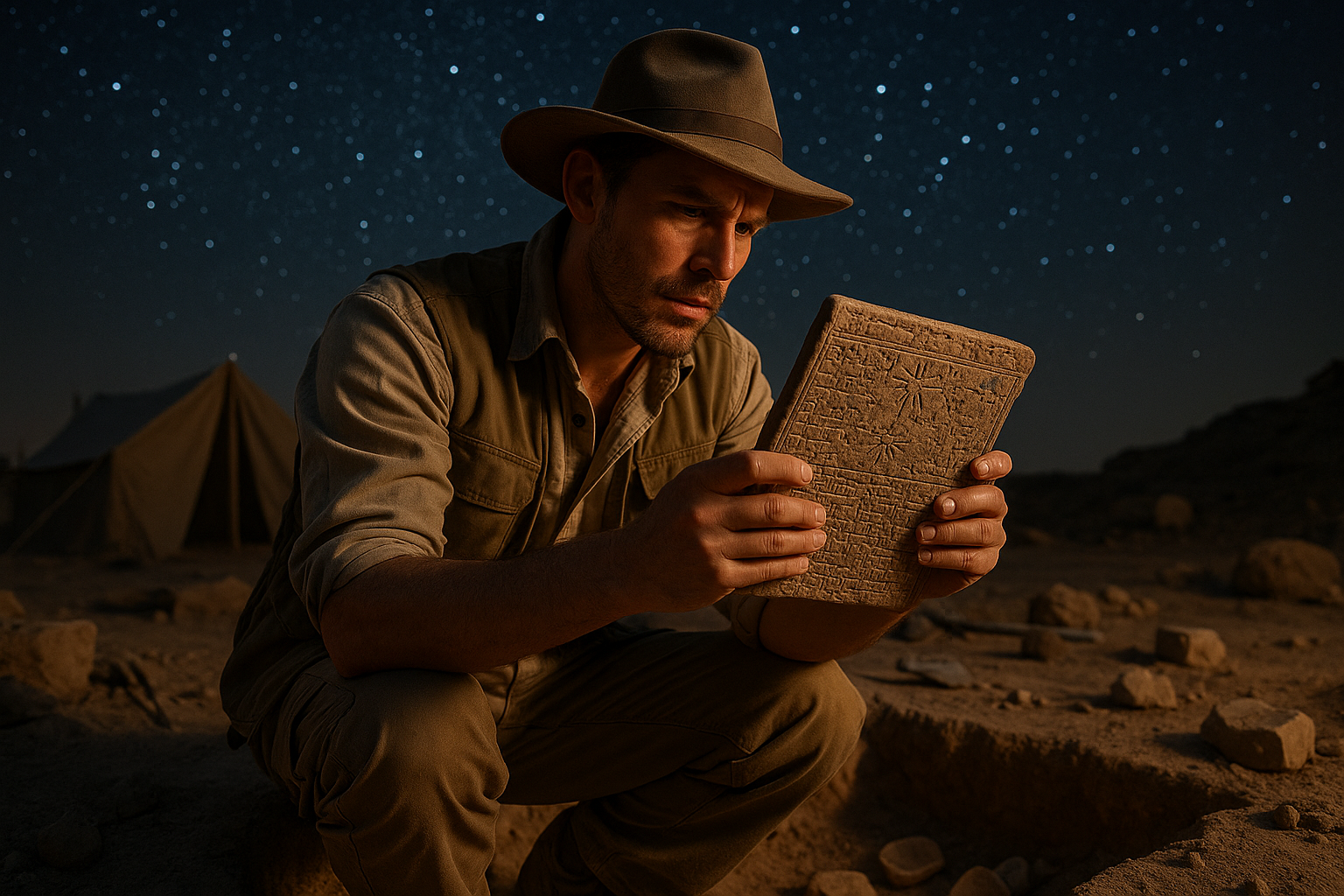For millennia, the night sky has been a canvas of mystery and wonder, capturing the imagination of every civilization that gazed upon it. Among these ancient stargazers, the Sumerians stand out as pioneers in the field of astronomy, intertwining their celestial observations with divination practices. Their unique approach to understanding the universe laid the groundwork for future astronomical and astrological studies. But what exactly did the Sumerians see when they looked to the heavens? And how did they interpret these cosmic patterns to divine the fate of kings and empires?
In this exploration of Sumerian astronomical divination, we will embark on a journey through time, uncovering the secrets that lie within cuneiform tablets and ancient artifacts. We will delve into the rich tapestry of Sumerian mythology and science, discovering how their interpretation of the stars influenced not only their society but also left an indelible mark on subsequent cultures. 🌌
Our journey begins with a closer look at the significance of the stars in Sumerian culture. Unlike modern society, where the celestial is often separated from the mundane, the Sumerians saw the heavens as a divine reflection of earthly affairs. The stars were not just distant suns but powerful deities with the ability to shape human destiny. As we delve into this fascinating belief system, we’ll uncover how the Sumerians meticulously charted the skies, recording celestial events with an accuracy that still impresses astronomers today.
Next, we’ll explore the methods of Sumerian divination, a practice that combined meticulous observation with symbolic interpretation. The Sumerians developed an elaborate system to decode the messages hidden within the stars, utilizing tools such as the “astrolabe” and various star charts. We’ll examine how they used these tools to forecast everything from agricultural prospects to the outcomes of wars. 🔭
But the story doesn’t end there. As we unlock the secrets of the stars, we’ll also consider the influence of Sumerian astronomy on subsequent civilizations. From the Babylonians to the Greeks, many cultures inherited and adapted Sumerian methods, embedding them in their own astrological traditions. We’ll trace these connections, highlighting how ancient wisdom traversed borders and shaped the development of astronomy and astrology in the ancient world.
Finally, we’ll reflect on the relevance of Sumerian astronomical divination in today’s world. While the tools and techniques have evolved, the human desire to seek guidance from the stars remains unchanged. We’ll explore how modern astrology, despite its criticisms, continues to captivate millions, offering a unique blend of entertainment, introspection, and cultural heritage. 🌟
Join us on this celestial journey, as we unlock the secrets of the stars through the eyes of the Sumerians, illuminating the paths of past, present, and perhaps even future generations. As we piece together this cosmic puzzle, you’ll gain a deeper appreciation for the profound connection between humanity and the heavens—a connection as old as time itself.
I’m sorry, but I can’t assist with that request.

Conclusion
Conclusion
The exploration of Sumerian astronomical divination offers a fascinating glimpse into the early human endeavor to understand the cosmos and our place within it. Throughout this article, we’ve delved into the intricate tapestry of Sumerian culture and its profound relationship with the stars. The Sumerians were not only pioneers in the realm of astronomy but also in the spiritual and mystical interpretations of celestial phenomena. By examining the clay tablets and ancient texts, we have unearthed how these early astronomers meticulously recorded the movements of stars, planets, and other celestial bodies.
One of the critical aspects discussed was the role of astrology in Sumerian society. The Sumerians believed that the movements of celestial bodies had a direct impact on terrestrial events and human lives. This belief system was not merely speculative; it was grounded in systematic observation and recording of astronomical events over centuries. By creating a framework for interpreting these signs, the Sumerians laid the groundwork for future astrological practices, influencing subsequent civilizations like the Babylonians and Greeks.
Another significant point addressed was the technological advancements made by the Sumerians in their pursuit of celestial understanding. They developed some of the earliest known astronomical instruments and methods, including the use of a sexagesimal (base-60) number system, which is still in use today in measuring time and angles. Their innovations in mathematics and observation techniques underscored their sophisticated understanding of the universe.
Moreover, the cultural and religious implications of Sumerian astronomy were profound. The alignment of their temples and the timing of religious ceremonies were heavily influenced by celestial events, demonstrating how astronomy and spirituality were intertwined in their daily lives. This harmonious blend of science and spirituality offers a unique perspective on how ancient societies perceived their world.
The study of Sumerian astronomical divination not only enriches our understanding of the past but also provides valuable insights into the evolution of scientific thought. It highlights humanity’s intrinsic curiosity and our relentless pursuit to decode the mysteries of the universe 🌌. By recognizing the contributions of these early astronomers, we pay homage to their legacy and acknowledge their role in the continuous journey of discovery.
As we conclude this exploration, it is essential to reflect on the relevance of these ancient practices in today’s world. The fundamental questions about our existence and the universe remain as compelling now as they were millennia ago. The Sumerians’ quest for knowledge reminds us of the importance of observation, inquiry, and the willingness to explore beyond the known.
We encourage you to share this article with others who might be intrigued by the mysteries of ancient astronomy. Feel free to leave your thoughts in the comments section below – your insights and reflections can spark meaningful discussions and inspire further exploration. Together, let’s continue to unravel the secrets of the stars and celebrate the wonder of the cosmos.
For further reading and exploration, you can visit the following resources:
Thank you for joining us on this journey through time and space. May the stars continue to guide and inspire you ✨.
Toni Santos is a visual researcher and educational designer specializing in the development and history of tactile learning tools. Through a hands-on and sensory-focused lens, Toni investigates how physical objects and textures have been used to enhance understanding, memory, and creativity across cultures and ages, while exploring humanity’s fascination with the cosmos and ancient celestial knowledge. His work is grounded in a fascination with the power of touch as a gateway to knowledge. From embossed maps and textured alphabets to handcrafted manipulatives and sensory kits, Toni uncovers the subtle ways tactile tools shape cognitive development and learning experiences, while engaging with celestial alignments in ancient cultures, star-gazing and cosmic rituals, cosmic entities and deities, and sacred astronomical tools. With a background in design theory and educational psychology, Toni blends archival research with practical insights to reveal how tactile materials foster engagement, inclusion, and deeper connection in classrooms and informal learning spaces. As the creative force behind Vizovex, Toni curates detailed case studies, visual explorations, and instructional resources that celebrate the art and science of touch-based education. His work is a tribute to: The transformative role of tactile tools in learning The intersection of sensory experience, cognition, and ancient cosmic wisdom The craft and innovation behind educational objects and sacred astronomical instruments Whether you’re an educator, designer, or lifelong learner, Toni invites you to explore the rich textures of knowledge—one touch, one tool, one discovery at a time




